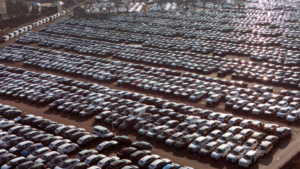United States President Donald Trump has announced a 25% tariff on all imported cars and auto parts to the United States, aiming to boost domestic production and reduce the trade deficit.
But what are the real implications of these announcements for automakers and the countries they come from?
Last year, the United States imported approximately $219.49 billion worth of cars, up 4% from the previous year. The main countries of origin of these imports were: Mexico with $49.98 billion and 22.8% of imports.
Japan with $40.76 billion and 18.6%, South Korea with $38.02 billion and 17.3%), Canada with $28.4 billion and dollars and having 12.9%, and Germany with 25.7 billion dollars, having 11.7% of car imports to the US.
The tariffs mainly hit companies such as Toyota and Honda, South Koreans such as Hyundai and Kia, and German ones such as BMW and Mercedes-Benz. Although many of these companies have production plants in the US, they still import a significant number of vehicles to meet demand.
The countries with the largest car exports to the US are expected to be most affected:
Mexico: As the largest exporter of cars to the US, Mexico faces serious economic consequences. The automotive industry is a major part of the Mexican economy, and tariffs could lead to reduced production and job losses.
Manufacturers: General Motors, Ford, Chrysler (Stellantis), Volkswagen, Nissan, Honda, BMW, Mercedes-Benz
South Korea: Tariffs will negatively affect Hyundai and Kia’s exports, possibly leading to a review of their production and export strategies. Manufacturers: Hyundai, Kia, Genesis.
Canada: With exports of $28.4 billion dollars, Canada will face challenges in its auto industry, with potential impacts on employment and economic growth. Manufacturers: Ford, General Motors, Stellantis, Honda, Toyota
Germany: German automakers such as BMW and Mercedes-Benz will face increased tariffs, affecting their prices and competitiveness in the US market. Manufacturers: BMW, Mercedes-Benz, Audi, Volkswagen, Porsche
Which automakers already produce in the US
Many companies already have production plants in America:
Toyota: Kentucky, Texas, Mississippi
Honda: Ohio, Alabama, Indiana
Nissan: Tennessee, Mississippi
Hyundai/Kia: Alabama, Georgia
BMW: Spartanburg, South Carolina
Mercedes-Benz: Alabama
Volkswagen: Chattanooga, Tennessee
Volvo: South Carolina
And of course Tesla: California, Texas (Gigafactory)
Tariffs also in Turkish spare parts
Turkey maintains a significant presence in the United States market through exports of mainly vehicle spare parts, contributing substantially to the country’s economy. In 2024, the total exports of the Turkish automotive industry amounted to $37.2 billion, setting a record for the industry.
The United States ranked ninth among Turkey’s top export markets for the automotive industry in 2024, with exports of $1.2 billion. It is worth noting that exports to the US have fluctuated in recent years:
- 2020: $951 million
- 2021: $1.2 billion
- 2022: $1.4 billion
- 2023: $1 billion
- 2024: $1.2 billion
The majority of exports to the United States are automotive parts and components. In 2024, exports of the Turkish supplier industry to the US exceeded $1 billion, representing a significant portion of total exports in this sector. The United States’ 25% tariffs on imports of automobiles and parts. This development is expected to negatively affect Turkish exports, especially in the parts sector, where Turkey has a significant presence. The additional tariffs will increase costs for Turkish companies, making their products less competitive in the US market.
Volkswagen’s response
Volkswagen of America, in response to the new tariffs announced by Donald Trump, plans to impose an additional “import fee” on vehicles assembled outside the US.
The company also suspended rail shipments of vehicles from Mexico to the United States, according to an internal memo to its dealers. The automaker expects the changes in U.S. tariffs to affect pricing for vehicles imported from Mexico and Europe starting April 3. The memo said production at the company’s Chattanooga assembly plant would also be affected, without elaborating. VW builds three models in Mexico: the Jetta compact sedan, the Taos midsize crossover and the Tiguan compact crossover. The Tiguan is historically VW’s best-selling model in the U.S. and was redesigned for the 2025 model year. Sales of the Jetta and Taos increased in the first quarter.
A VW spokesman said the automaker is assessing the impact on a vehicle-by-vehicle basis and has not made any final decisions on pricing, which will depend on factors such as a vehicle’s trim level. The situation remains fluid, but VW officials acknowledge that the tariffs have caused concern among dealers and consumers.
VW dealers have a 50- to 60-day inventory of new vehicles, close to the level the brand typically seeks to maintain. “We are keeping the interests of our dealers and customers in mind and once we have quantified the impact on the business, we will share our strategy with our dealers,” a VW spokesman said in a statement.
VW has temporarily suspended rail shipments from Mexico, but said shipping from the Puebla plant, as well as from Europe, is continuing as normal. Rail transport accounts for a small percentage of VW models produced and distributed outside of Mexico.
However, any vehicles delivered to U.S. ports after the tariffs are imposed will be held at the port and will not be priced or delivered to dealers in the near term.
VW builds the Atlas and Atlas Cross Sport large crossovers in Tennessee, along with the ID4 electric compact crossover. Two VW models are being imported from “It is important to note that no vehicles that will be available to dealers in early April will have the duty added,” the memo said. VW plans to implement a two-phase vehicle allocation program in April. In the first cycle, which will begin April 7-8, vehicles not affected by the tariffs will be priced normally with no additional import fees. In the second round, which is expected to begin on April 22-23, vehicles that may be affected will include the new import tax, according to a Volkswagen memo to its dealer network.
The company says full details on the amount of the new tax and the models that will be subject to it will be provided before the start of the second distribution phase, so that dealers can be prepared to manage communication with their customers.
Americans bought Japanese and European cars to beat tariffs
Automobile sales in the United States were brisk in the first quarter of 2025 as consumers rushed to beat the upcoming price increases due to the 25% tariffs that are set to be imposed on all imported cars and light trucks from April 3.
According to the latest official data, the first quarter of 2025 saw a total of 3,835,000 new vehicle sales in the US, up 5.1% from the same period last year. The seasonally adjusted annualized sales rate (SAAR) in March was 17.8 million, the highest since 2021, according to GlobalData.
Automakers and sales changes:
General Motors: 690,339 sales (+17%)
Toyota Motor North America: 570,269 sales (+0.9%)
Lexus: 83,043 sales (+5.8%)
Ford Motor Co.: 508,083 sales (-1.3%)
Stellantis: 332,540 sales (-12%)
Honda Motor Co.: 351,577 sales (+5.3%)
Nissan Group (including Infiniti): 267,085 sales (+5.7%)
Hyundai Motor America: 203,554 sales (+10%)
Kia America: 198,850 sales (+11%)
Subaru of America: 166,957 sales (+9.1%)
Volkswagen: 87,915 sales (+6%)
Tesla: 140,000 (estimate for the U.S., -5.6%)
Rivian: 8,640 sales (-36%)
The quarter’s winners were GM, which saw growth thanks to strong SUVs and electric models, Kia and Hyundai, which recorded record sales, and Honda, with its hybrid and new electric offerings strengthening its momentum.
The quarter’s losers were Tesla, which saw its first serious decline since the pandemic, and Rivian, which fell 36% due to production restrictions and external factors (fires in LA). Stellantis continued its downward trend, recording its seventh consecutive quarterly decline.
Tariff uncertainty has prompted companies to fill warehouses and dealerships, while imported models like the Mercedes GLA may be withdrawn from the market. Companies are expected to reassess their strategy after April 3, with price adjustments and changes to the models offered in the US expected.
Ask me anything
Explore related questions





